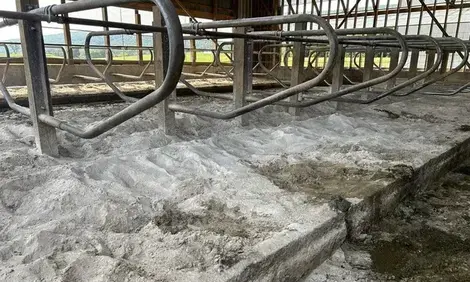



Weekly global protein digest: EU milk production forecast up slightly
Market analyst Jim Wyckoff shares highlights from this week's activities in the global protein market.USDA: European Union milk production forecast up slightly
In 2022, milk production in the European Union 27 Member States (EU27) is forecast to increase by 0.2 percent to 150.45 million metric tons (MMT) compared to 2021, said USDA. As EU liquid milk consumption is flat, most additional milk goes to processing. Cheese production is the main use and EU27 cheese production is forecast to increase to 10.4 MMT, which is 50,000 MT more than in 2021 and 168,000 MT more than in 2020. Both EU domestic cheese consumption and exports continue to increase. EU butter production is forecast to recover to 2.14 MMT in 2022, after a decrease in 2021 compared to 2020, for lack of milk and at the expense of exports. Non-Fat Dry Milk production is also forecast to recover to 1.56 MMT in 2022, after a decrease in 2021 compared to 2020, resulting in lower exports. EU27 Whole Dry Milk production is most affected by stagnating milk production, with significant production cuts in both 2021 and 2022 and lower exports.
USDA: Milk production in Australia to rise
Milk production in 2022 in Australia is forecast to increase moderately to 9.1 million metric tons (MMT) after a falling in 2021 to an estimated 9.0 MMT, a one percent decline from 2020. The shortage of labor influenced by COVID-19 lockdowns in the major dairy farming states and Australia’s international border closure, led to some dairy farms partially or fully transitioning to less labor-intensive beef cattle production. This had a negative impact on milk production in 2021 and is also expected to limit the growth in milk production for 2022. Despite lower milk production in 2021, insatiable demand for dairy products by China has driven a strong growth in exports of milk and all of the dairy manufactured product segments.
Tyson Foods sees rise in sales despite raising prices for its beef, chicken and pork
Faced with a US tight labor market, Tyson has raised wages and added benefits like sick leave for plant workers to help boost staffing. The Arkansas-based meat firm lifted prices across all of its major divisions as cost of cattle jumped by one-fifth year over year in the quarter ended Oct. 2. Tyson’s logistics expenses climbed about 30%, executives said, while the company also has paid more for ingredients and packaging materials. Tyson, which produces roughly 1 of every 5 pounds of chicken, beef and pork in the U.S., and other meatpackers have been struggling to keep up with demand from supermarkets and reopening restaurants. A nationwide labor shortage has left many processing plants understaffed.
Over the most recent quarter, its average beef prices rose by nearly one-third since last year, while pork prices jumped by 38% and chicken about 19%.“The inflation we incur needs to be passed on,” said finance chief Stewart Glendinning. Tyson’s earnings rose to $1.36 billion in the fourth quarter, more than doubling from that period last year, and its beef unit’s operating margins jumped from 9.7% a year ago to 22.9%. Meantime, Smithfield Foods will develop a preparedness plan for infectious diseases. Smithfield will pay a $13,494 penalty for failing to protect workers from the coronavirus at its South Dakota slaughter plant in 2020 and will develop a company-wide preparedness plan against infectious diseases, the Labor Department said on Monday. Smithfield closed the plant in Sioux Falls for 25 days during a Covid-19 outbreak that infected 1,294 workers and killed four of them.
US pork, beef export sales rise in latest week
USDA Thursday morning reported US pork net sales of 25,000 MT for 2021 were up 7 percent from the previous week, but down 16 percent from the prior 4-week average. Increases primarily for Mexico (16,900 MT, including decreases of 600 MT), Japan (3,800 MT, including decreases of 200 MT), Canada (1,600 MT, including decreases of 600 MT), Colombia (1,100 MT, including decreases of 100 MT), and Australia (700 MT, including decreases of 100 MT), were offset by reductions for South Korea (900 MT). Net sales of 5,100 MT for 2022 were primarily for South Korea (4,200 MT) and Australia (800 MT). Exports of 34,700 MT were up 9 percent from the previous week and 6 percent from the prior 4- week average. The destinations were primarily to Mexico (16,200 MT), Japan (4,600 MT), China (4,400 MT), South Korea (3,000 MT), and Colombia (2,100 MT).
US beef net sales of 25,500 MT for 2021 were up 23 percent from the previous week and 58 percent from the prior 4- week average. Increases primarily for China (13,800 MT, including decreases of 200 MT), Taiwan (3,600 MT, including decreases of 100 MT), Japan (3,200 MT, including decreases of 500 MT), South Korea (1,700 MT, including decreases of 500 MT), and Mexico (800 MT, including decreases of 100 MT), were offset by reductions for Colombia (100 MT). For 2022, net sales of 4,600 MT were primarily for South Korea (2,600 MT), Japan (1,300 MT), and China (400 MT). Exports of 18,200 MT were up 8 percent from the previous week and from the prior 4- week average. The destinations were primarily to South Korea (5,400 MT), Japan (4,100 MT), China (3,200 MT), Mexico (1,500 MT), and Taiwan (1,100 MT).
Chinese pork imports fall sharply from year-ago in October
China imported 200,000 MT of pork in October, which was down 4.8% September but 41.1% lower than last year. Through the first 10 months of this year, China imported 3.34 MMT of pork, a 7.7% drop from the same period last year.
USDA’s annual livestock, dairy, and poultry outlook
US beef exports as a share of production are expected to fall slightly from 12.4 percent in 2021 to 12.1 percent in 2022. Both production and exports of beef are expected to decrease from 2021 to 2022. The share of U.S. pork production exported is expected to increase from 26.0 to 26.8 percent from 2021 to 2022, as production is forecast to decline slightly in 2022 while exports increase by about 3 percent year over year.
In 2021, broiler exports are expected to account for 16.8 percent of domestic production. In 2022, this share is forecast to decline slightly to 16.5 percent, as production is forecast to increase by about 1 percent and exports are forecast to decline by about 1 percent year over year. Turkey exports as a share of production are forecast at 10.0 percent in 2021 and 10.1 in 2022; both production and exports are forecast to increase slightly from 2021 to 2022. Egg and egg product exports in 2021 are expected to be 5.2 percent of table egg production. In 2022, this share is forecast to decrease slightly to 4.6 percent as exports return to more typical levels and production increases by about 1 percent year over year. Dairy exports on a skim-solids milk-equivalent basis are expected to account for 22.7 percent of milk production in both 2021 and 2022, as both production and exports are forecast to increase by about 1 percent year over year.
Beef/Cattle: The forecast for 2021 commercial beef production was raised fractionally from last month to 27.885 billion pounds on robust cattle slaughter and heavier carcass weights. Fed and feeder steer prices were raised in 2021 fourth quarter. September’s beef imports totaled 284 million pounds, down 5 percent from a year ago. The 2021 annual forecast for beef imports was raised 50 million pounds from last month to 3.260 billion pounds. September’s beef exports were up 289 million pounds, 20.9 percent over the previous year. The annual forecast for 2021 beef exports was raised by 41 million pounds to 3.455 billion pounds. The forecast for 2022 was unchanged from last month at 3.270 billion pounds.
Dairy: U.S. milk production growth has slowed in recent months, and aggregate milk production growth among major dairy-exporting countries has also declined. U.S. milk production forecasts have been lowered for 2021 and 2022 due to lower expected milk cow numbers and milk per cow. The all-milk price for the fourth quarter of 2021 is projected to average $20.00 per hundredweight (cwt), an increase of $0.20 from last month’s forecast. For the year, the all-milk price forecast is $18.50 per cwt, an increase of $0.05 from the previous projection. The all-milk price forecast for 2021 is $20.25 per cwt, an increase of $1.05 from last month’s projection.
Pork/Hogs: Continued lower processing demand for hogs in the fourth quarter is expected to be largely offset by heavier average dressed weights, leaving the commercial pork production forecast largely unchanged from last month at 7.2 billion pounds, down by more than 4 percent from the same period a year ago. Forecasts for pork exports both this year and in 2022 are unchanged from last month. This year, exports are forecast at 7.2 billion pounds, down about 1 percent, and in 2022 exports are expected to be 7.4 billion pounds, 3 percent higher than shipments in 2021.
Poultry/Eggs: The broiler production forecast was increased in the fourth quarter on strong preliminary slaughter data and positive placement data. Broiler export forecasts were also increased in the fourth quarter and for 2022. Broiler price forecasts were increased in the fourth quarter and the first half of 2022 on recent price trends. The forecasts for table egg production for fourth quarter and first half of 2022 were revised up on recent trends in the rates of lay. The wholesale egg price forecast for the fourth quarter was lowered to 125 cents per dozen due to lower-than-expected late-October and early November prices. Due to robust foreign demand, egg and egg product exports were revised up for the current quarter and the first two quarters of next year. Forecast turkey production was increased in the first quarter of 2022 on positive placement data. Turkey export forecasts were also increased in the fourth quarter and in 2022. Based on strong but volatile turkey prices in recent weeks, the fourth quarter forecast price was increased to 135 cents per pound and the 2022 forecast price was adjusted up to 122 cents per pound.
HPAI detected in commercial layer flock in Japan
On November 10, Japan’s Ministry of Agriculture, Forestry, and Fisheries confirmed a detection of highly pathogenic avian influenza (HPAI) in a commercial layer flock near Yokote City, Akita Prefecture. This was followed by detection of two more cases in Izumi City, Kagoshima Prefecture, on November 13th and 15th. In total, about 193,000 chickens will be culled. Japan’s last detection of HPAI in commercial chicken flocks was in March 2021.
TheCattleSite News Desk
IMPORTANT NOTE: I am not a futures broker and do not manage any trading accounts other than my own personal account. It is my goal to point out to you potential trading opportunities. However, it is up to you to: (1) decide when and if you want to initiate any traders and (2) determine the size of any trades you may initiate. Any trades I discuss are hypothetical in nature.
Here is what the Commodity Futures Trading Commission (CFTC) has said about futures trading (and I agree 100%): 1. Trading commodity futures and options is not for everyone. IT IS A VOLATILE, COMPLEX AND RISKY BUSINESS. Before you invest any money in futures or options contracts, you should consider your financial experience, goals and financial resources, and know how much you can afford to lose above and beyond your initial payment to a broker. You should understand commodity futures and options contracts and your obligations in entering into those contracts. You should understand your exposure to risk and other aspects of trading by thoroughly reviewing the risk disclosure documents your broker is required to give you.



